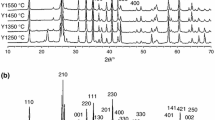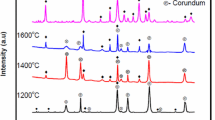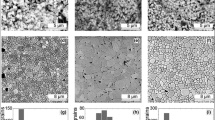Abstract
Coprecipitated mullite precursor powders of the bulk compositions 78 wt% Al2O3+22 wt% SiO2 (high-Al2O3 material) and 72 wt% Al2O3+28 wt% SiO2 (low-Al2O3 material) have been used as starting materials. The precursor powders were calcined at 600, 950, 1000, 1250, and 1650‡ C, and test sintering runs were performed at 1550, 1600, 1650, 1700, and 1750‡ C. Homogeneous and dense ceramics were obtained from cold isostatically pressed (CIPed) powders sintered in air at 1700‡ C. Therefore, all further sintering experiments were carried out at 1700‡ C. After pressureless sintering, sample specimens were hot isostatically pressed (HIPed) at 1600‡ C and 200 bar argon gas pressure. Sintering densifications of low Al2O3 materials ranged between ≈94% and ≈95.5%. There was no clear dependency between densification and calcination temperature of the starting powders. High-Al2O3 compositions displayed sintering densities which increased from ≈97% at 600‡ C calcination temperature to ≈99% at 950‡ C calcination temperature. Higher calcination temperatures first caused slight lowering of the sintering density to ≈95.5% (calcination temperature 1250‡ C) but later the density strongly decreased to a value of 85% (calcination temperature 1650‡ C). HIPing of pressureless sintered specimens prepared from powders calcined between 600 and 1100‡ C yielded 100% density. At the given sintering temperature of 1700‡ C, the microstructure of sample specimens was influenced by Al2O3/SiO2 ratios and by calcination temperatures of the starting powders. Homogeneous and dense microstructures consisting of equiaxed mullite plus some minor amount of α-Al2O3 were produced from high-Al2O3 powders calcined between 600 and 1100‡ C. Low-Al2O3 sample specimens sintered from precursor powders calcined between 600 and 1100‡ C were less dense than high-Al2O3 materials. Their microstructure consisted of relatively large and elongated mullite crystals which were embedded in a fine-grained matrix of mullite plus a coexisting glass phase. The different microstructural developments of high- and low-Al2O3 compositions may be explained by solid-state and liquid-phase sintering, respectively. The microstructure of HIPed samples was very similar to that of pressureless sintered materials, but without any pores occurring at grain boundaries.
Similar content being viewed by others
References
I. Aksay, D. M. Dabbs andM. Sarikaya,J. Am. Ceram. Soc. 74 (1991) 2343.
J. D. Heaps, S. B. Schuldt, B. L. Grung, J. D. Zook andC. D. Butter, in “IEEE Proceedings of the 30th Electronic Components Conference” (1980) pp. 39–48.
G. Celotti, L. Morettini andG. Ortelli,J. Mater. Sci. 18 (1983) 1005.
S. Prochazka andF. J. Klug,J. Am. Ceram. Soc. 66 (1983) 874.
R. F. Davis andJ. A. Pask, in “Refractory Materials. High Temperature Oxides”, Part IV, Refractory Glasses, Glass-Ceramics, and Ceramics, edited by A. M. Alper (Academic Press, New York, London, 1971) pp. 37–76.
J. A. Pask andA. P. Tomsia,J. Am. Ceram. Soc. 74 (1991) 2367.
S. Somiya andY. Hirata,Ceram. Bull. 70 (1991) 1624.
H. Schneider, Habilitationsschrift, Faculty of Chemistry, University of Münster, Germany (1986).
H. Schneider, L. Merwin andA. Sebald,J. Mater. Sci. 27 (1992) 805.
H. Schneider, B. Saruhan, D. Voll, L. Merwin andA. Sebald,J. Eur. Ceram. Soc.,11 (1993) 87.
F. J. Klug, S. Prochazka andR. H. Doremus,J. Am. Ceram. Soc. 70 (1987) 750.
F. J. Klug, S. Prochazka andR. H. Doremus,Ceram. Trans. 6 (1990) 15.
B. Kanka andH. Schneider, unpublished results.
M. D. Sacks andJ. A. Pask,J. Am. Ceram. Soc. 65 (1982) 65.
Idem, ibid. 65 (1982) 70.
S. Kanzaki, H. Tabata, andT. Kumazawa,Ceram. Trans. 6 (1990) 339.
M. G. M. U. Ismail, Z. Nakai andS. Somiya,ibid. 6 (1990) 231.
M. D. Sacks, H. Lee andJ. A. Pask,ibid. 6 (1990) 167.
Y. Hirata andK. Shimada, in “Mullite”, edited by S. Somiya (Uchida Rokakuho, Tokyo, Japan, 1985) pp. 89–122.
P. D. D. Rodrigo andP. Boch,Int. J. High Technol. Ceram. 1 (1985) 3.
Idem, J. Phys. 47 (1986) C1–411. C1–416.
Author information
Authors and Affiliations
Rights and permissions
About this article
Cite this article
Kanka, B., Schneider, H. Sintering mechanisms and microstructural development of coprecipitated mullite. J Mater Sci 29, 1239–1249 (1994). https://doi.org/10.1007/BF00975071
Received:
Accepted:
Issue Date:
DOI: https://doi.org/10.1007/BF00975071




